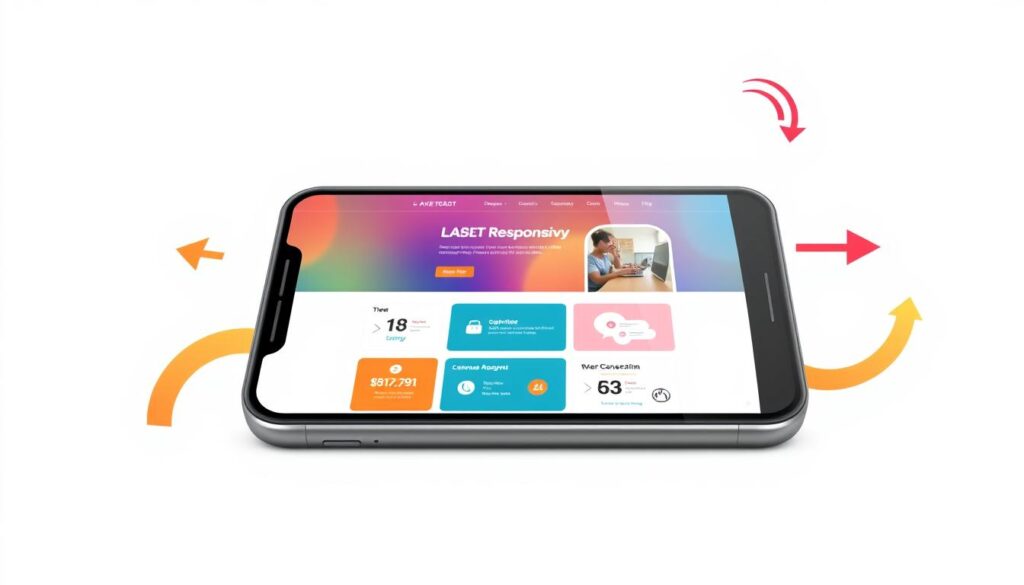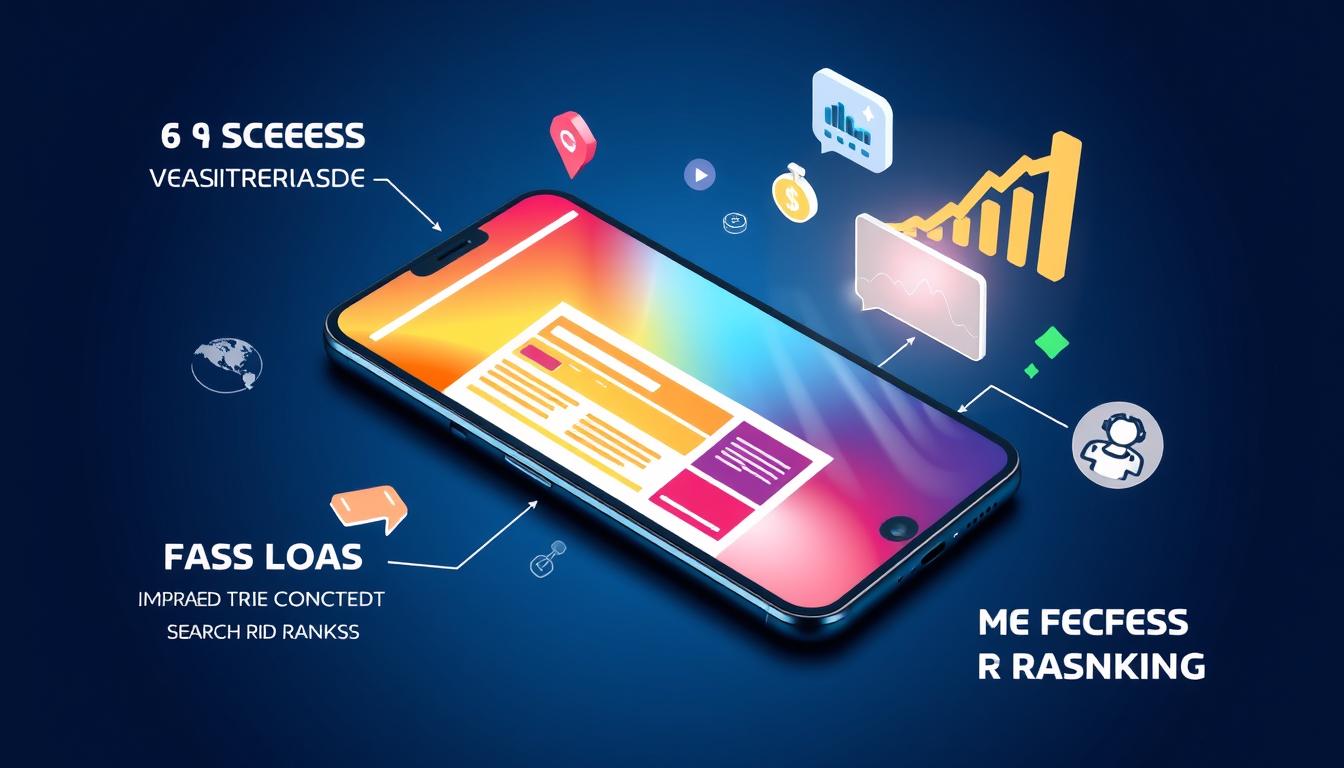|
Getting your Trinity Audio player ready...
|
Imagine you’re on a crowded bus, scrolling through your phone. You’re looking for a quick answer but face slow-loading pages and tiny text. This is a common problem in today’s fast world. Mobile optimization is no longer a luxury but a must.
Your mobile experience is crucial. With over 60% of web traffic coming from mobile devices, search engines are paying attention. Google now prioritizes your site’s mobile version over the desktop version for rankings. It’s time to make the switch or risk falling behind.
Mobile optimization is more than just fitting content on a smaller screen. It’s about creating a smooth experience that keeps users coming back. A mobile-friendly website can lower bounce rates and increase time spent on site. These are important factors for search engines when ranking pages.
But how do you know if your site is mobile-friendly? Start with responsive design, making sure your content looks good on any device. Then, focus on speed—mobile users expect pages to load in under 3 seconds. Also, consider user experience elements like easy-to-tap buttons and readable text without zooming.
By using effective mobile SEO strategies, you’re not just improving your search performance. You’re also giving value to your users. And that’s what search engines reward the most. Are you ready to improve your mobile optimization? Let’s get started.
Understanding Mobile-First Indexing
Google’s search approach has changed with the rise of mobile devices. In 2018, they started using mobile-first indexing. This change affects how websites are ranked and shown in search results.
What is mobile-first indexing?
Mobile-first indexing means Google mainly looks at a site’s mobile version for indexing and ranking. This change is because more people use smartphones and tablets to access the internet.
Why Google prioritizes mobile content
Google wants to give the best search experience with billions of mobile users. They focus on mobile content to meet most users’ needs.
Impact on search rankings
Mobile-first indexing has a big impact on Google search rankings. Sites with good mobile versions rank higher. To keep or boost your ranking, make sure your site works well on all devices.
Your mobile site should have the same content and data as your desktop site. This way, you rank for the same keywords on both. By focusing on mobile, you’ll attract more mobile users and get more organic traffic.
Creating a Mobile-Friendly Website

In today’s world, having a mobile-friendly website is essential. Over 70% of internet time is spent on mobile devices. Google now ranks sites based on their mobile version first.
Responsive web design is crucial for mobile optimization. It makes sure your site works well on all devices. Speed is important. If pages take more than 3 seconds to load, nearly half of visitors will leave.
Make your site easy to navigate on mobile. Use big buttons and simple menus. Add features like click-to-call and easy forms. Mobile-friendly sites see 74% of users come back, unlike non-optimized ones.
Mobile shopping is big, with 76% of consumers doing it on their phones. By focusing on mobile design, you improve user experience and profits. Users are 5 times more likely to leave non-mobile-friendly sites, so it’s worth the effort.
Ensuring Content Parity Between Desktop and Mobile
Content parity is key in today’s mobile-first world. Over 60% of web traffic now comes from mobile devices. It’s vital to offer a consistent experience on all platforms. Google also favors mobile-friendly sites in its search rankings.
Importance of Equivalent Content
Keeping content the same on desktop and mobile is crucial for search rankings. Google likes sites that have the same main content on both. This ensures your site can rank for the same keywords on any device.
Studies show mobile-optimized sites have lower bounce rates. Non-optimized sites see much higher bounce rates.
Strategies for Content Adaptation
When making content mobile-friendly, keep the main message the same. Use accordions or tabs to save space. Keep headings clear and meaningful on both versions.
This helps keep users engaged for 3-4 minutes, as seen on mobile-optimized sites.
Avoiding Content Reduction on Mobile
Don’t cut content on your mobile site. Instead, organize information to fit smaller screens. This supports content parity and improves user experience.
Mobile-optimized sites see 3-4 pages per session. Non-optimized sites see 1-2. By keeping content comprehensive, you boost engagement and conversion rates.
Optimizing Site Speed for Mobile Devices

In today’s world, how fast your website loads on mobile is key. Over 51% of people use their phones to surf the web. If your site is slow, 53% of visitors will leave in just 3 seconds.
Start by checking your site with tools like Google PageSpeed Insights. They show you what needs work and give tips. To speed up, reduce redirects, shrink images, and use browser caching. Google says mobile pages should load in under 3 seconds and be under 500 KB.
Using lazy loading for images and videos helps a lot. It makes sure visitors see important stuff first. Also, combining and minifying JavaScript and CSS files cuts down on server requests, making your site faster.
Improving mobile site speed does more than just make users happy. It also helps your site rank better on Google. Fast sites keep people engaged, reduce bounce rates, and increase your earnings.
Mobile Optimization for Improved Search Performance
In today’s world, mobile SEO is key for businesses. Over 50% of web traffic comes from mobiles. Making your site mobile-friendly is essential for better online visibility and user engagement.
Key Elements of Mobile SEO
Mobile optimization best practices include making content easy to read on mobiles. Also, improve site load times and focus on local SEO. A one-second delay can cause a 7% drop in conversions.
To fix this, use browser caching. It can cut loading times by 40% for repeat visitors.
Best Practices for Mobile Optimization
To boost your mobile SEO, use short paragraphs and avoid annoying popups. Make your content easy to read on small screens with bullet points and clear headings. Image optimization techniques can reduce file size by up to 70% without losing quality, improving site speed.
Tools for Measuring Mobile Performance
Use tools like Google Search Console, Mobile-Friendly Test Tool, and PageSpeed Insights to check your site’s mobile performance. These tools show where you can improve your search performance optimization. By keeping up with mobile trends, your site will stay competitive online.
Enhancing User Experience on Mobile

Mobile UX design is key in today’s digital world. Most people use smartphones to access the internet. So, making your site mobile-friendly is crucial. It should be easy for users to navigate and enjoy your content.
To get users engaged, keep your mobile layout simple. Use short, clear text and divide it into small paragraphs. Add bullet points and subheadings to make it easier to read. Mobile users quickly scan content, so highlight important info.
Speed is also important in mobile UX design. Make your site load faster by compressing images and reducing scripts. Even a small delay can cost you business. Try using lazy loading for images to improve performance.
Responsive design is essential for a good experience on all devices. It makes sure your site looks great on any screen size. Regularly check your site’s responsiveness to ensure it works well on different mobile devices.
Finally, focus on making your site touch-friendly. Use big, easy-to-tap buttons and space out clickable items. This will make users happier and keep them on your site longer.
Implementing Responsive Design
Responsive web design is crucial for a mobile-friendly website. It makes your site work well on all screen sizes. This ensures a smooth experience for everyone.
Benefits of Responsive Design
A responsive website makes browsing better on any device. It lowers bounce rates and increases user engagement. Since over 60% of web traffic is from mobiles, it’s very important.
Techniques for Implementation
To make a responsive site, use fluid grids and flexible images. These adjust to fit different screen sizes. CSS media queries are also key.
They let you set styles for different screen widths. Always test your design on various devices for the best results.
Testing Responsiveness
Testing regularly is key for a responsive site. Use Google’s Mobile-Friendly Test to check your site. Fast load times are crucial to avoid high bounce rates.
By focusing on responsive design, you’ll enhance user experience and search performance.
Leveraging Mobile-Specific Features for SEO
Mobile-specific SEO is key in today’s world. Most people use smartphones to search the web. Making your site mobile-friendly can really help your search rankings.
Local search optimization is a big deal for mobile SEO. Many searches on mobile are about local stuff. So, it’s important to claim and update your Google Business Profile. Make sure your business info is the same everywhere.
Voice search optimization is also crucial. More people use voice assistants. So, make your content sound natural. Use long-tail keywords and questions that people ask out loud.
Structured data is a strong tool for mobile SEO. It helps search engines get your content. This can lead to better search results with more clicks, bringing more visitors to your site.
Using these mobile-specific features can make your SEO strategy strong. A good mobile site doesn’t just rank better. It also keeps users interested, which can lead to more sales.
Conclusion
Mobile optimization is key in today’s digital world. Since 2017, over 50% of website traffic comes from mobile devices. This shows how important it is to focus on mobile SEO.
Responsive design ensures a smooth experience on all devices. This is crucial for keeping visitors and lowering bounce rates.
Google favors mobile-friendly sites, making mobile optimization vital for rankings. Investing in mobile optimization boosts local search visibility. This is especially true with the 500% rise in “near me” searches.
This increased visibility leads to more organic traffic and potential customers. It’s a big win for businesses.
To boost your mobile SEO, work on site loading speed. Cut down server response times and optimize images. Use browser caching too.
Pages that load in 6-10 seconds are more likely to keep visitors. By improving these areas, you’ll enhance user experience and meet Google’s web vitals.
In short, mobile optimization is now a must for better search performance. By following these tips, your business will stay ahead in the digital world.

